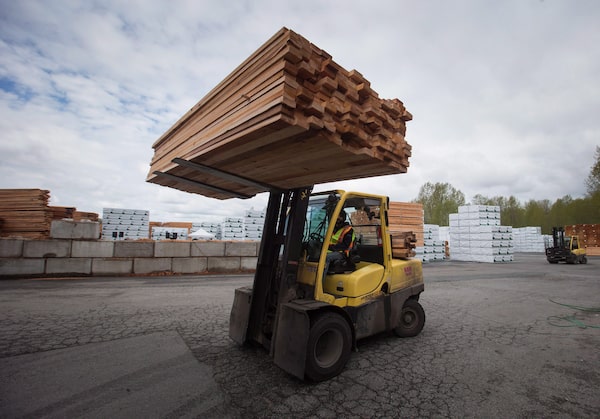
A worker uses a forklift to move lumber at the Partap Forest Products mill in Maple Ridge, B.C., on April 25, 2017.DARRYL DYCK/The Canadian Press
U.S. home builders are urging the Biden administration to negotiate a new softwood deal with Canada after lumber costs for a single-family house tripled over the past year to nearly US$53,000.
The United States currently imposes duties of almost 9 per cent on most Canadian softwood shipped south of the border, resulting in higher costs for a commodity that is already expensive. Lumber prices surged to record highs last week amid strong demand and constrained supply.
“We harbour great optimism that with this new administration, there is hope for a path forward on a new softwood lumber agreement,” the Washington-based National Association of Home Builders, or NAHB, said in a statement to The Globe and Mail.
NAHB chairman John Fowke wrote a letter dated April 22 to new U.S. Trade Representative Katherine Tai, saying bilateral negotiations are needed to resolve the cross-border dispute.
John Horgan predicts tough times for B.C. forest sector as protests continue
“The anti-dumping and countervailing duties currently in place on imported softwood lumber from Canada are aggravating already high lumber prices,” Mr. Fowke said. “A resolution to the U.S.-Canada softwood lumber dispute would help ease market concerns for builders and consumers alike.”
Lumber contracts last month went for three to four times higher than in April, 2020. Benchmark two-by-fours made from Western spruce, pine and fir sold last week for a record US$1,420 for 1,000 board feet, quadrupling in price over the past year, according to industry newsletter Madison’s Lumber Reporter.
Lumber prices initially fell in the spring of 2020 as the COVID-19 pandemic delayed home renovations and housing starts. But lumber demand soared in the summer as people stuck at home embarked on do-it-yourself projects such as decks while housing starts began accelerating as many families sought more space by moving to larger homes in the suburbs.
The NABH has the backing of 35 industry groups in the U.S. that are part of the lumber supply chain, including the National Affordable Housing Management Association. The NABH and its allies are leading the campaign to persuade U.S. President Joe Biden’s administration to resolve this latest round of the long-running dispute that dates back to the early 1980s.
But the U.S. Lumber Coalition, which represents American producers and private woodland owners, is a powerful lobby group that wants to preserve the duties.
The U.S. and Canada have different systems for charging producers to chop down trees.
The coalition blames Canada. Most of the forests in Canada are on Crown land, with buyers paying “stumpage fees” to provincial governments for the right to log. The core of the coalition’s view on Canadian lumber is that the wood is unfairly subsidized and sold at below market value.
By contrast, the coalition argues that the U.S. has a better system for soliciting competitive bids for private timber rights, based on market forces.
The 2006 Canada-U.S. softwood agreement expired in October, 2015, and the issue of duties is still mired in cumbersome dispute-resolution procedures.
During a hearing on April 28 by the U.S. Senate committee on appropriations, Ms. Tai left the door open for softwood negotiations with Mary Ng, Canada’s International Trade Minister. “In my initial conversation with my Canadian counterpart, Minister Ng of Canada, we did raise our bilateral issues – the long-standing ones, especially,” Ms. Tai said, referring to their discussion on March 22. “Softwood lumber will always be in my sights in the conversation with Canada.”
U.S. Senator Susan Collins, a Republican from Maine, said during the hearing that with sky-high lumber prices, it’s important to hold talks. “We obviously would prefer domestic sources, but when domestic sources can’t meet the demand as is the case right now and prices are so high, we desperately need a new agreement to be negotiated,” Ms. Collins said.
Youmy Han, a spokeswoman in Ottawa for Ms. Ng, said the federal government would defend Canada’s softwood industry in any prospective bilateral talks. “Minister Ng raised this issue with both President Biden and Ambassador Tai and we look forward to working with this administration on this important issue,” Ms. Han said in an e-mail.
Under the previous Trump administration, the U.S. Department of Commerce started imposing duties on Canadian lumber in April, 2017.
The Commerce Department reduced the duties for most Canadian producers in late 2020 to 8.99 per cent, compared with 20.23 per cent previously. Montreal-based Resolute Forest Products Inc., however, has been paying at a tariff rate of 20.25 per cent for the past five months.
The duties are being scrutinized under an administrative review at the Commerce Department, which could adjust rates by the end of this year.
The coalition maintains that even with the spike in lumber prices, it’s land and labour costs that account for much of the price inflation in home construction.
But Paul Emrath, the NABH’s vice-president of surveys and housing policy research, said lumber supplies cost US$16,927 in the construction of new American single-family houses in April, 2020, and that has increased by US$35,872 over the past year to US$52,799.
Data from the U.S. Census Bureau show that the price for a new single-family home sold in the U.S. averaged US$397,800 in March, 2021, up 10 per cent from April, 2020.
Canadian producers have paid deposits for duties totalling nearly $5-billion since the spring of 2017, industry analysts estimate.
Resolute chief executive officer Remi Lalonde said in an interview that he is cautiously optimistic about a fresh start with Mr. Biden in power. “We think it would be welcome news for both Canadian producers and American home buyers if the U.S. administration would continue this encouraging change in tone,” Mr. Lalonde said. “Trade barriers in whatever form inflate prices and they slow economic recovery.”
Your time is valuable. Have the Top Business Headlines newsletter conveniently delivered to your inbox in the morning or evening. Sign up today.